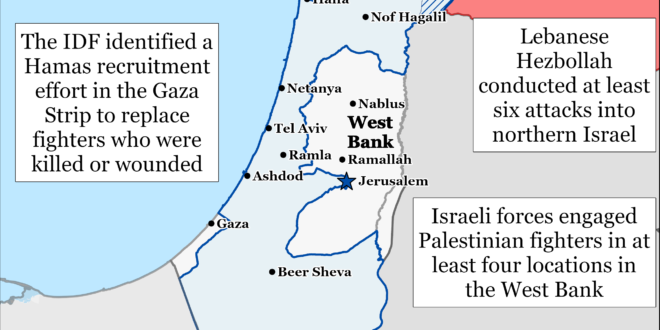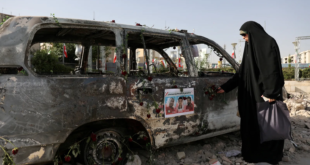Hamas appears to be accelerating its reconstitution effort in the Gaza Strip. Hamas is actively recruiting 18-year-olds and has attempted to conduct training for new recruits.[i] Recruitment is one element of the second stage of reconstitution, regeneration. Reconstitution consists of two general tasks, reorganization and regeneration. Reorganization involves a commander redistributing the resources at their disposal to restore attrited units to a minimal level of effectiveness.[ii] Regeneration is a more complex, time-intensive, and resource-intensive process “that requires large-scale replacement of personnel, equipment, and supplies.”[iii] This process includes training of new personnel.[iv] Active Hamas recruitment efforts indicate that at least some Hamas commanders have begun to regenerate the forces under their command.
Hamas will likely continue to try to exploit the lack of Israeli forces throughout much of the Gaza Strip by executing both reorganization and regeneration efforts to reconstitute itself.[v] A commander usually must disengage their force from opposing forces to successfully and efficiently reconstitute. Hamas taken advantage of Israeli withdrawals in much of the Gaza Strip to rebuild the combat power of degraded local battalions, integrate new forces, and prepare them for further combat activities. Recruitment and training are key components of restoring combat units, which will enable Hamas to prepare for further engagements with the IDF.[vi]
Hamas appears to be successfully reconstituting itself militarily and politically in areas where the IDF is no longer present. Repeated Israeli raids into Gaza City suggest that Hamas is successfully reconstituting itself militarily, prompting the raids. A senior Israeli defense official said that Hamas is focusing on recovery and rehabilitation across the Gaza Strip, particularly in areas where the IDF is no longer operating.[vii] Hamas is also working to reassert local control in Khan Younis by deploying fighters on the streets, managing local policing, and taking over humanitarian aid shipments.[viii] Hamas is restoring its governing arms as well, which has prompted the IDF to target Hamas officials involved in these activities.[ix]
The Houthis claimed on June 22 that they conducted a combined attack with Iranian-backed Iraqi militias targeting five vessels in and around Haifa Port.[x] The Islamic Resistance in Iraq and the Houthi military spokesperson issued separate but complimentary statements claiming to target four commercial vessels in the Haifa Port using drones on June 22.[xi] The Houthi military spokesperson said that the groups targeted two unnamed “cement tankers” and two cargo ships that violated the Houthis’ unofficial blockade of Israel.[xii] The groups also claimed a drone attack on a Luxembourg-flagged livestock carrier in the Mediterranean Sea as it approached Haifa Port.[xiii] CTP-ISW cannot verify whether any attack occurred. These attacks mark the third time that the Houthis have claimed a combined operation targeting Israel with the Islamic Resistance in Iraq since June 6.[xiv] The growing cooperation between the Houthis and Iranian-backed Iraqi militias furthermore reflects the desire of the Axis of Resistance to present itself as an interoperable coalition.[xv]
Iranian-backed Iraqi militias likely conducted two drone attacks targeting US forces at al Tanf Garrison in eastern Syria on June 22. Iranian-backed militia Telegram accounts, Syrian media, and international journalists reported that three drones targeted al Tanf Garrison in two separate attack waves on June 22.[xvi] No group has claimed responsibly for the attack at the time of this writing and CTP-ISW cannot verify whether any attack occurred.
The attacks may be linked to a likely Israeli strike that killed a Kataib Sayyid al Shuhada (KSS) militant in Albu Kamal, eastern Syria, on June 21.[xvii] Iranian-backed Iraqi militia Kataib Hezbollah and KSS blamed the United States for the June 21 airstrike.[xviii] Combined Joint Task Force-Operation Inherent Resolve categorically denied on June 22 that US or other coalition forces conducted an airstrike on the Iraq-Syria border.[xix] Local opposition media reported the strike targeted an Iranian-backed militia vehicle transporting weapons near an ammunition warehouse.[xx]
The Iraqi Resistance Coordination Committee issued a statement suggesting a consensus among Iranian-backed Iraqi militias to resume attacks targeting US forces on June 19.[xxi] The reported al Tanf garrison drone attacks do not confirm that the Islamic Resistance in Iraq has decided to restart its attack campaign targeting US forces in Iraq and Syria, however. Unspecified actors have previously conducted unclaimed attacks targeting US positions in Syria since the Islamic Resistance in Iraq paused its attack campaign.[xxii] Kataib Hezbollah has been driving efforts to resume attacks on US forces since at least April 2024 after its resistance to Islamic Revolutionary Guards Corps Quds Force Commander Brig. Gen. Esmail Ghaani‘s original order to stop attacks in January.[xxiii] Emirati state media reported in April 2024 that Islamic Resistance in Iraq militia leaders disagreed with Kataib Hezbollah’s calls to resume attacks targeting US forces in Iraq.[xxiv]
Key Takeaways:
- Hamas Reconstitution: Hamas appears to be accelerating its reconstitution effort in the Gaza Strip by beginning to regenerate its forces through recruitment. Hamas appears to be successfully reconstituting itself militarily and politically in areas where the IDF is no longer present.
- Yemen: The Houthis claimed on June 22 that they conducted a combined attack with Iranian-backed Iraqi militias targeting five vessels in and around Haifa Port.
- West Bank: Israeli forces have engaged Palestinian fighters in at least four locations in the West Bank since CTP-ISW’s last data cutoff on June 22.
- Southern Lebanon and Golan Heights: Lebanese Hezbollah has conducted at least six attacks into northern Israel since CTP-ISW’s last data cutoff on June 22.
- Iraq: Iranian-backed Iraqi militias likely conducted two drone attacks targeting US forces at al Tanf Garrison in eastern Syria on June 22. The reported al Tanf garrison drone attacks do not confirm that the Islamic Resistance in Iraq has decided to restart its attack campaign targeting US forces in Iraq and Syria, however.
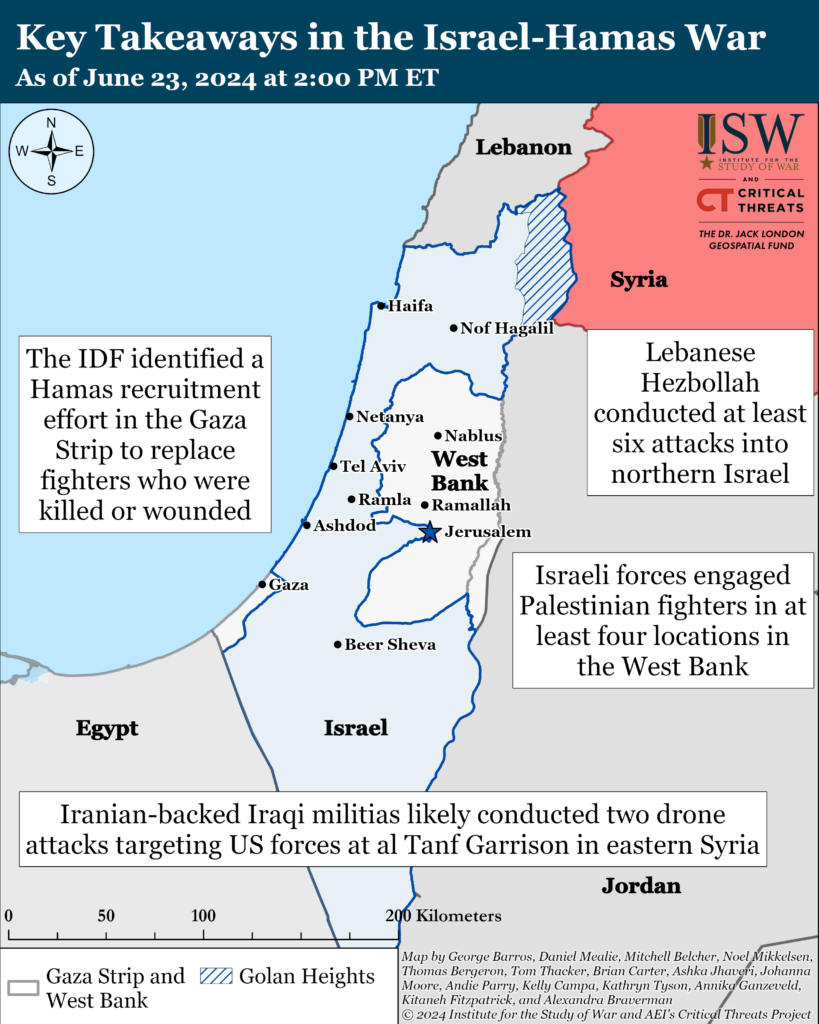
Gaza Strip
Axis of Resistance objectives:
Erode the will of the Israeli political establishment and public to sustain clearing operations in the Gaza Strip
Reestablish Hamas as the governing authority in the Gaza Strip
The Israel Defense Forces (IDF) 99th Division continued operations south of Gaza City along the Netzarim Corridor on June 23.[xxv] The IDF engaged Palestinian fighters at close range.[xxvi] Palestinian militias conducted five separate rocket attacks targeting Israeli forces along the corridor, specifically on al Rashid Road.[xxvii] Al Rashid Road runs along the Gazan coastline. The section that travels through the Netzarim Corridor is close to the US-built humanitarian pier. The IDF Air Force struck a UN Relief and Works Agency for Palestinian Refugees (UNRWA)-run school in Gaza City targeting Hamas and Palestinian Islamic Jihad fighters and reportedly killing eight Palestinians.[xxviii] The school also served as a shelter for displaced people and aid distribution site.[xxix] Hamas and PIJ were operating from or near the school, prompting the airstrike.
The IDF 162nd Division continued clearing operations in Rafah.[xxx] The IDF 401st Brigade cleared and destroyed a Hamas training site in Tal al Sultan in western Rafah that belonged to Hamas’ local battalion.[xxxi] Israeli forces located the battalion commanders’ headquarters, as well as a weapons depot and tunnel shafts. They also raided the office of a Hamas officer responsible for the Rafah Brigade’s rocket fire targeting the IDF within the Gaza Strip and in Israel.
Hamas claimed a multi-stage, complex attack west of Tal Zorob in Rafah. Hamas fighters fired an anti-tank grenade at an IDF engineering vehicle and subsequently fired rockets at an IDF quick reaction force that arrived at the scene.[xxxii]
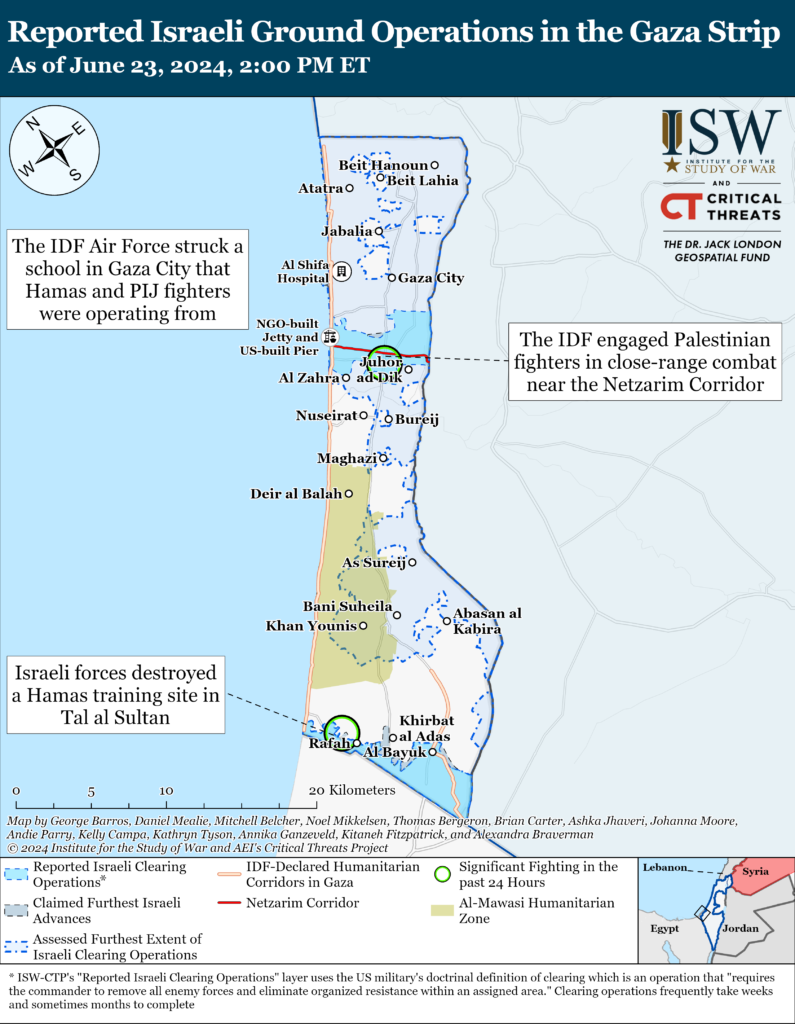
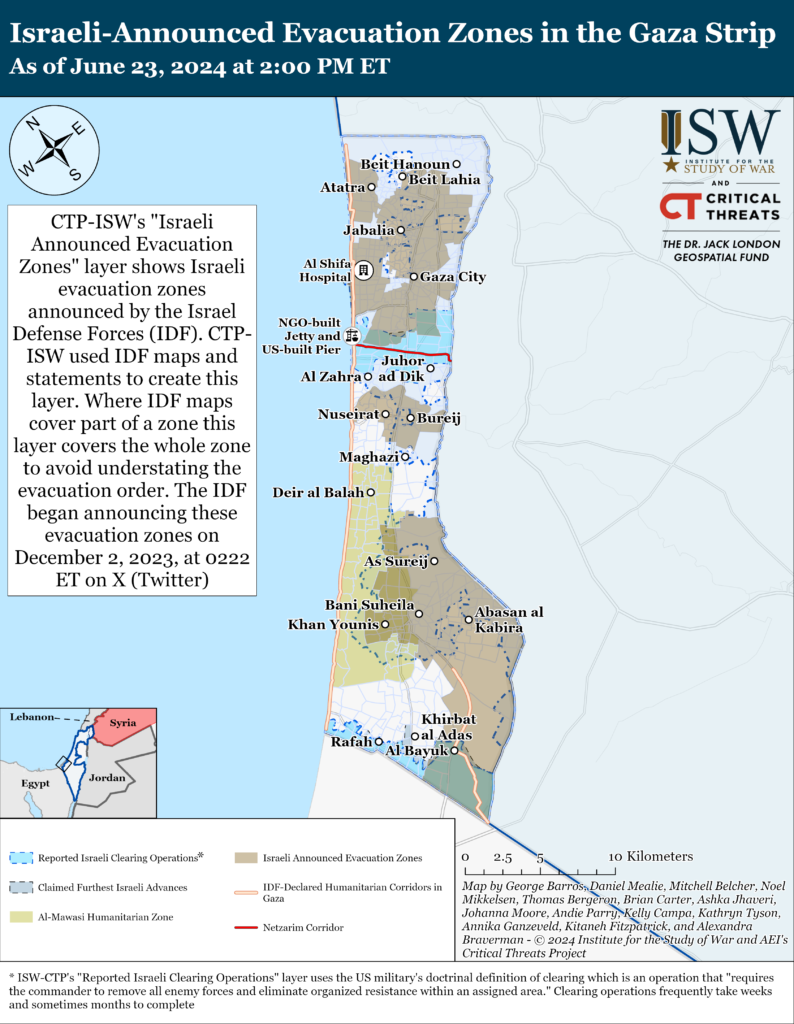
Palestinian militias conducted one indirect fire attack from the Gaza Strip into southern Israel on June 23. PIJ, the al Aqsa Martyrs’ Brigades, and the Popular Front for the Liberation of Palestine (PFLP) conducted a combined mortar attack targeting an IDF site near Kissufim.[xxxiii]
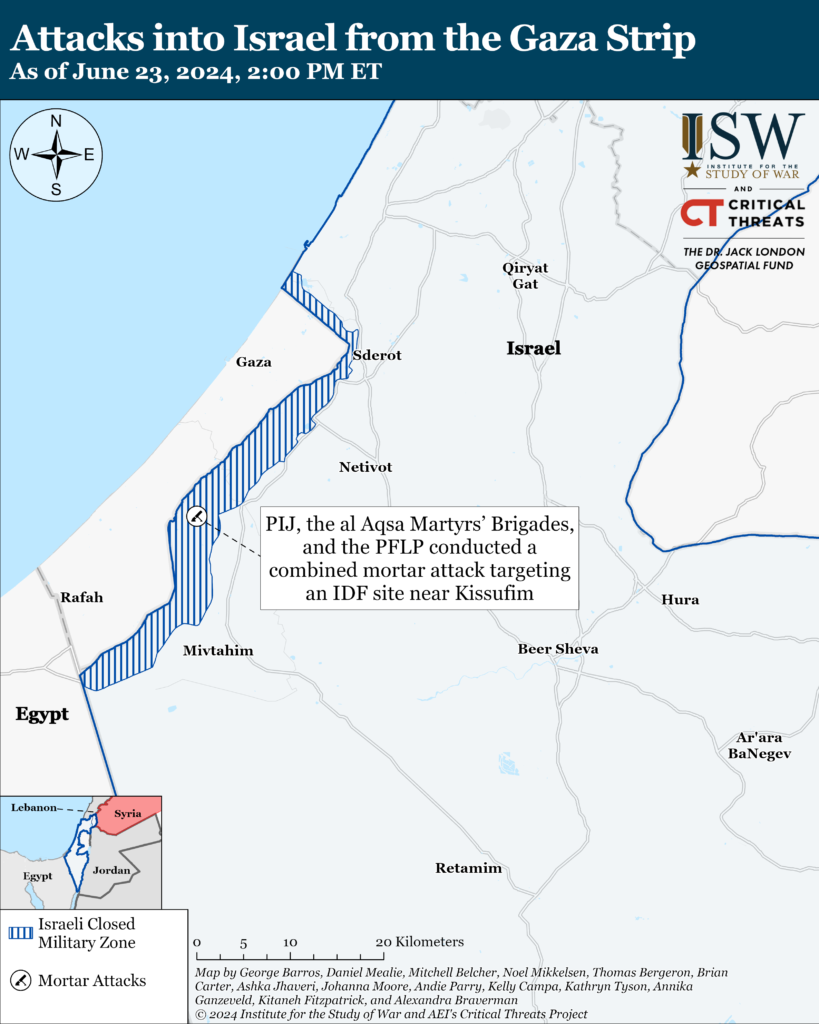
Recorded reports of attacks; CTP-ISW cannot independently verify impact.
ADD NOTE
TWEET
West Bank
Axis of Resistance objectives:
Establish the West Bank as a viable front against Israel
Israeli forces have engaged Palestinian fighters in at least four locations in the West Bank since CTP-ISW’s last data cutoff on June 22.[xxxiv]
Israeli forces detained 13 wanted Palestinians in the West Bank in overnight raids on June 23.[xxxv] The IDF also confiscated materials for manufacturing improvised explosive devices in Qalqilya.[xxxvi]
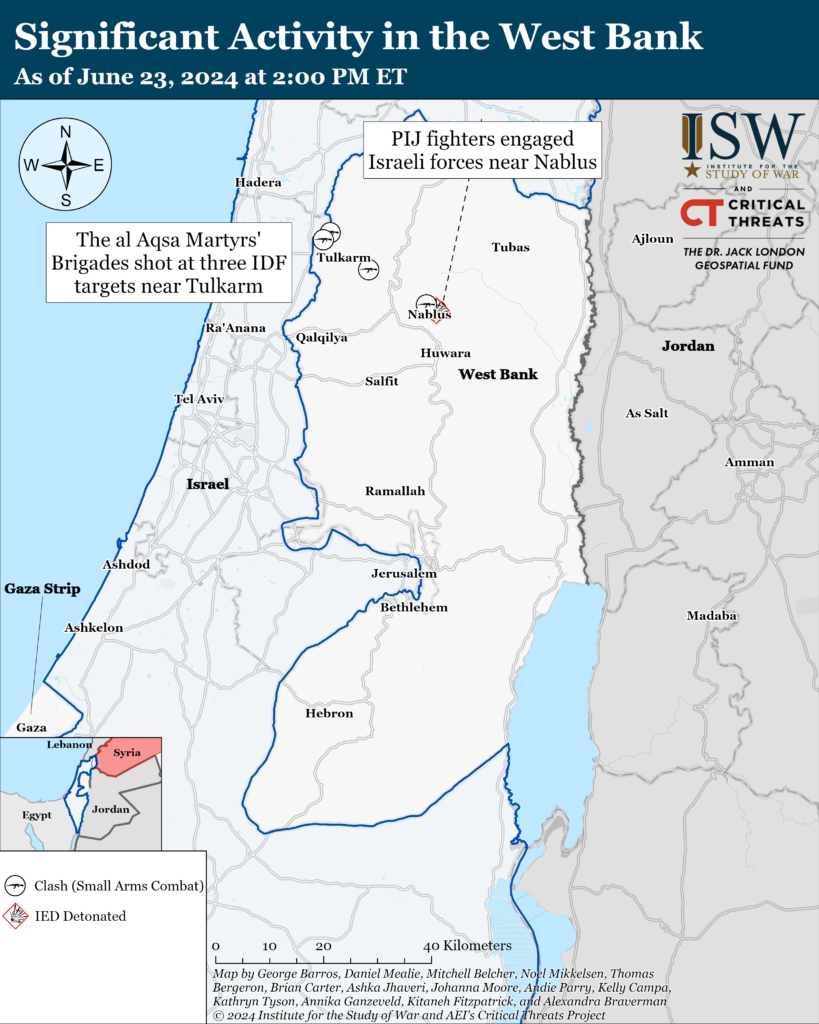
This map is not an exhaustive depiction of clashes and demonstrations in the West Bank.
Southern Lebanon and Golan Heights
Axis of Resistance objectives:
Deter Israel from conducting a ground operation into Lebanon
Prepare for an expanded and protracted conflict with Israel in the near term
Expel the United States from Syria
Lebanese Hezbollah has conducted at least six attacks into northern Israel since CTP-ISW’s last data cutoff on June 22.[xxxvii] The IDF intercepted a drone in the Misgav area.[xxxviii] Hezbollah did not claim responsibility for the attack.
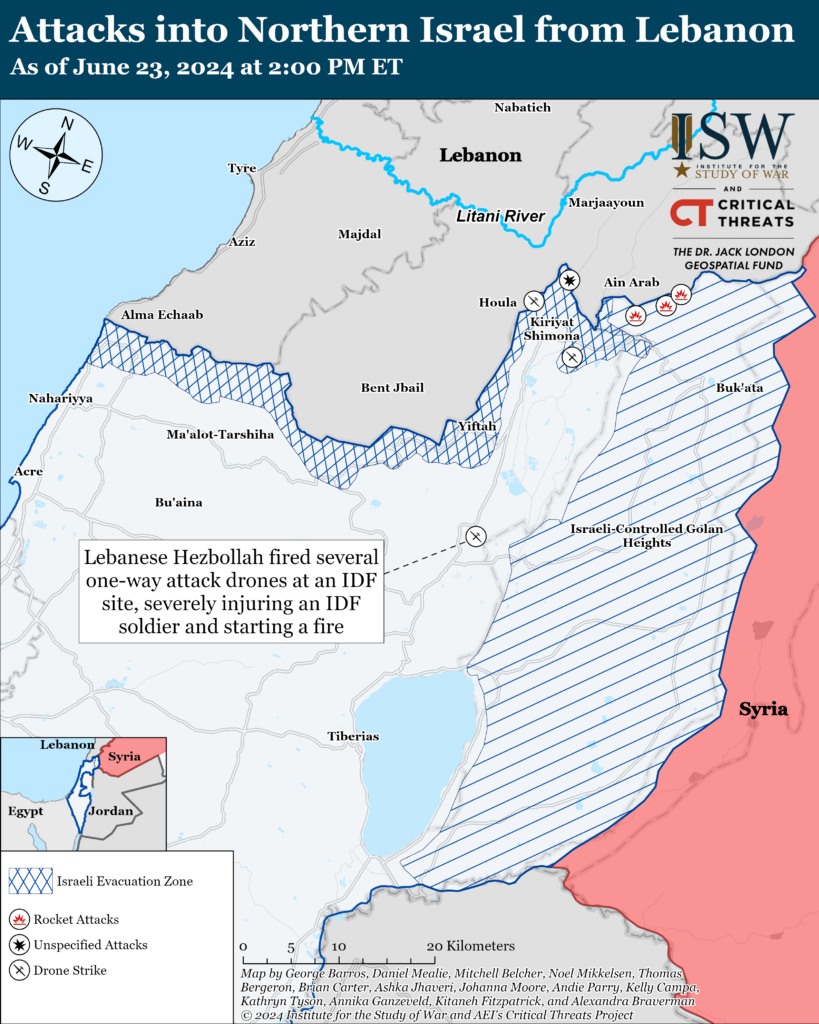
Recorded reports of attacks; CTP-ISW cannot independently verify impact.
Iran and Axis of Resistance
The Islamic Resistance in Iraq has claimed two drone attacks targeting unspecified “vital” sites near Eilat and the Dead Sea in Israel since CTP-ISW’s last data cutoff on June 22.[xxxix] The IDF confirmed that it intercepted a drone approaching Israel from the east which may have been launched by the Islamic Resistance in Iraq.[xl]
The Houthis have likely struck two vessels in the Gulf of Aden and the Red Sea since CTP-ISW’s last data cutoff on June 22.[xli] United Kingdom Maritime Trade Operations (UKMTO) reported that a vessel experienced uncontrollable flooding that forced the crew to abandon ship 96 nautical miles southeast of Nishtun, Yemen.[xlii] It remains unclear at the time of writing if the flooding was caused by a Houthi attack. The UKMTO reported separately that a drone struck and damaged a vessel 65 nautical miles west of al Hudaydah, Yemen.[xliii]
US Central Command (CENTCOM) reported that its forces intercepted three Houthi uncrewed surface vessels in the Red Sea on June 22.[xliv] CENTCOM also reported that the Houthis fired three anti-ship ballistic missiles into the Gulf of Aden.[xlv] CENTCOM stated the missiles did not cause casualties or “significant damage.”[xlvi]
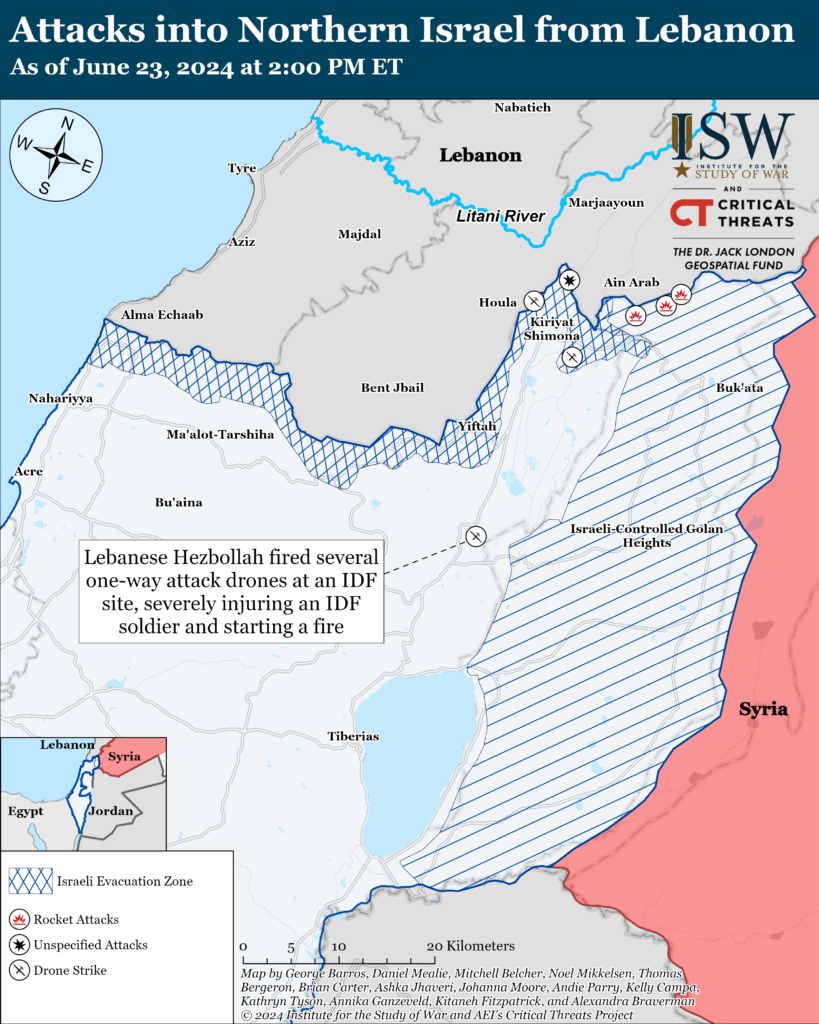
 Eurasia Press & News
Eurasia Press & News
